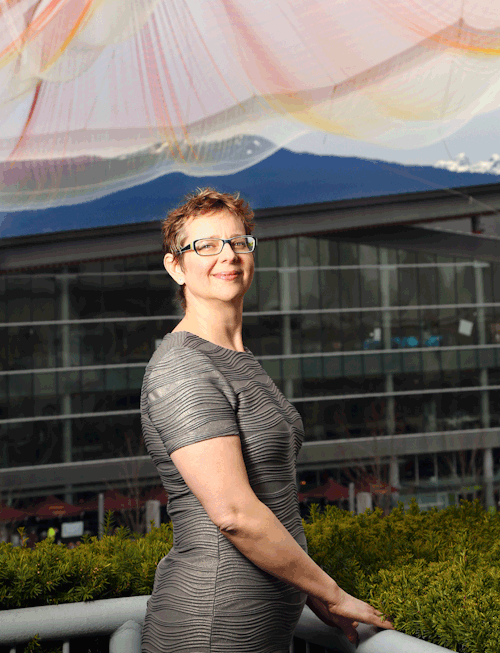Meet a NYFA Artist: Janet Echelman
Interactive sculpture, social spaces, and more
NYFA talks to Janet Echelman (Fellowship, Architecture/Environmental Structures, 2006) about her most recent work, Skies Painted With Unnumbered Sparks, a sculpture of braided fibers that spanned 745 feet in downtown Vancouver as part of the TED Conference’s 30th Anniversary in March. A collaboration with digital artist Aaron Koblin, the work invited interaction: viewers could control the visuals projected onto it through their mobile devices.
NYFA: Congratulations on what has been described as your “most ambitious project yet,” Skies Painted With Unnumbered Sparks, which was installed in Vancouver as part of the TED Conference’s 30th Anniversary. Tell us about the development of this project.
JE: The evolution of this artwork to celebrate the anniversary of the TED conference began with my research into how cities have been creating social spaces for millennia. I learned that the Coliseum in Rome had a monumental textile covering suspended from ropes called a velarium, which I imagine gave them a sense of togetherness despite their being gathered to watch violent spectacle. As the conference was meant to parlay ideas worth spreading, I posed the question: What would a velarium for our time be?
As I developed the sculpture, I was seeking to enhance its social potential with interactive lighting. So I reached out to the inspiring digital artist I’d met at TED, Aaron Koblin. Aaron leads the Data Arts team at Google, and they created the means so visitors could make gestures on their mobile devices; the web browser is projection-mapped onto the sculpture. Art critic Mary Louise Schumacher called it “a social space that is simultaneously physical and virtual,” and that’s exciting to me as an artist.
NYFA: Why did you choose the title Skies Painted With Unnumbered Sparks?
JE: I usually can’t name an artwork until I meet it. As I was finishing this sculpture, I read these words by Shakespeare — written in the 16th century about events from ancient Rome — which leaped across time to connect my exploration of an ancient Roman velarium translated to meet the social needs of our time.
Of course, I’m inverting the meaning that Shakespeare’s character implies. Julius Caesar speaks of himself as “constant as the northern star” and differentiates himself from other people, the “unnumbered sparks” around him. It’s ironic in many ways, but I’m especially drawn to the fact that we now know the North Star is not at all constant, and that it changes as the earth shifts its position in the galaxy. And this artwork acknowledges and empowers each member of the public to literally “paint the sky” with projected light onto the sculpture hovering above them.
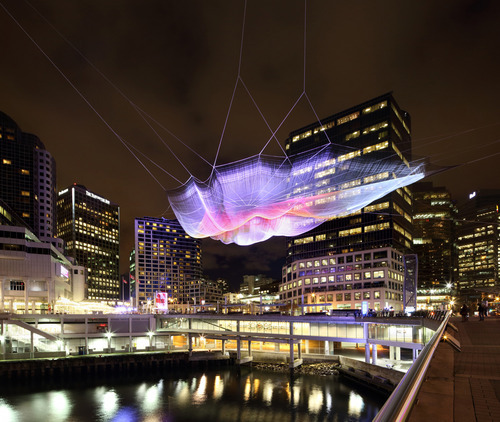
NYFA: This is both the largest and most interactive sculpture installation that you’ve ever produced. Did you run into any challenges during design or production?
JE: My goal was to sculpt at the scale of the city, as a soft counterpoint to hard-edged buildings. I wanted to lace into the fabric of the city, attaching exclusively to pre-existing structures.
My first big hurdle was that the kind of computer software tools I needed to do this simply did not exist. Fortunately, a company that builds design tools (Autodesk) believed in my idea from the start, and their engineers dedicated two years to develop the tool we needed.
Another hurdle was convincing tall buildings to let me attach to their roofs. Just hoisting this 745-foot sculpture into the air in the midst of an active city seemed impossible. It was like a dream when our team worked through the night to gently lift it over bus shelters and trees to alight above water, plaza, and street.
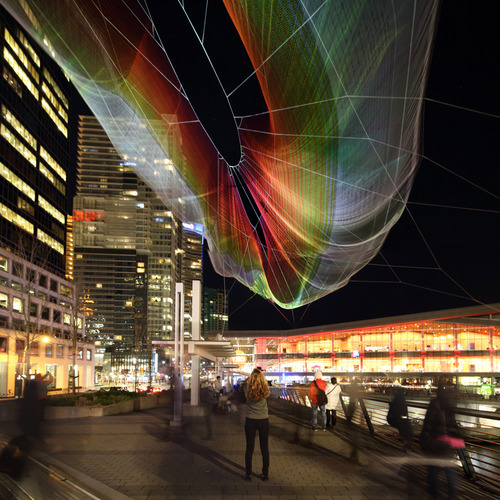
NYFA: Viewers can’t help but be captivated by the size of your sculptures. Can you talk about how scale fits into your creative process; have you always been inclined to work large?
JE: Scale is not an end in itself. It’s about the relationship of the art to the human body and to the physical context — in this case, a downtown filled with skyscrapers of an international city. I started as a gestural abstract painter, and I see this sculpture as a gesture through the city at the right proportion to its environment. To build at this scale, our engineers from Arup helped us create a lightweight structure strong enough to withstand 96-mph winds with loads exceeding 30,000 pounds, using a fiber called Spectra® that is 15 times stronger than steel. This is the largest pre-stressed rope structure in the world — and with the hurdles we had to overcome, we now know why.
NYFA: What are your plans for Skies Painted With Unnumbered Sparks?
JE: I designed it to travel from city to city, to attach to pre-existing buildings. There are several cities now discussing its installation, and I will say that nothing would make me happier than for it to come to New York!
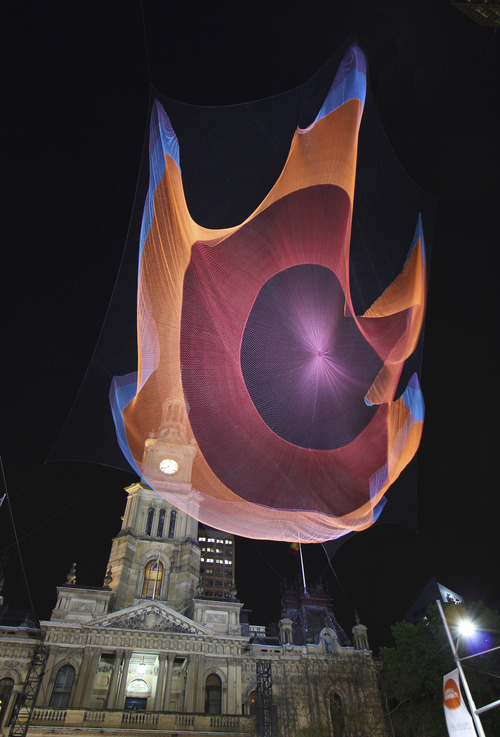
NYFA: Your artistic career path included a fair share of adversity — rejection from art schools, ten years as a struggling painter, and arriving in India to prepare for an exhibition with no materials to work with, etc. Based on what has helped you in the past, what advice do you have for artists struggling to overcome hardship?
JE: I always return to the words of poet Rainer Maria Rilke in Letters to a Young Poet, “Have patience with everything unresolved in your heart and to try to love the questions themselves as if they were locked rooms or books written in a very foreign language. Don’t search for the answers, which could not be given to you now, because you would not be able to live them. And the point is, to live everything. Live the questions now.”
NYFA: Your 2011 TED Talk is called “Taking Imagination Seriously.” What does taking imagination seriously mean to you?
JE: Listening to my intuitive responses, and treating nascent ideas with respect. I think it’s important to not to censor ideas, or minimize what we imagine at the beginning. Since there will always be time later to compromise and adapt to practical limitations, I think it’s important to make sure there’s a protected place to journal or sketch the fullest range of your vision. When I first started, I was making little models no larger than the size of my hands, but I imagined myself at the size of an ant inside them, and that experience fueled my trajectory.
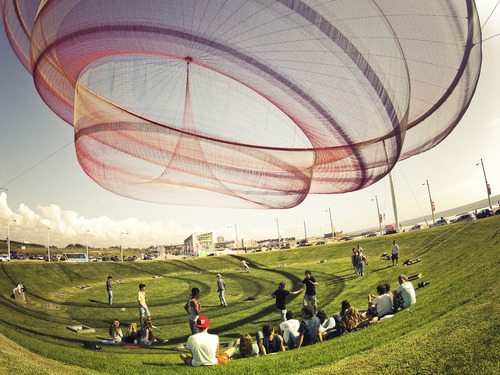
NYFA: You were awarded a NYFA Fellowship in Architecture/Environmental Structures in 2006. How did this award impact you at that point in your career?
JE: The NYFA grant was so important. It gave me concrete support to move my sculpture forward at a difficult time, and perhaps even more importantly, made me feel my work was valued and worthwhile.
For more information, please visit Janet’s website and watch her 2011 Ted Talk.

